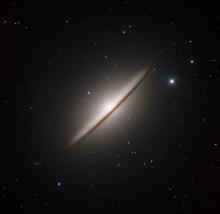Listen to today's episode of StarDate on the web the same day it airs in high-quality streaming audio without any extra ads or announcements. Choose a $8 one-month pass, or listen every day for a year for just $30.
You are here
Swift Kick
A black hole that formed from the merger of two smaller ones may have kicked itself out of its home galaxy.
The merger happened in a galaxy about three billion light-years from Earth. That was too far to see with normal telescopes. But the merging black holes produced a huge outburst of gravitational waves — tiny ripples in space-time. Detectors “heard” the merger in early 2020, so it was cataloged as GW200129. Scientists converted the waves to sound, and slowed them down a bit to reveal the merger.
The signal revealed important details about the merger. It told scientists that the original black holes had a combined mass about 75 times that of the Sun. The merger produced a single black hole about 60 times the Sun’s mass. The rest of their mass was converted to gravitational waves.
Computer models indicated that the two black holes had different masses and spins. Because of that, the gravitational waves fired off mainly in one direction. That pushed the black hole in the opposite direction.
The black hole probably was kicked at more than three million miles per hour. The scientists don’t know anything about GW200129’s home environment — what kind of galaxy it lived in, or if it was in a cluster inside the galaxy. Regardless, that should be fast enough for the black hole to escape most galaxies and zip into intergalactic space — a swift kick provided by the black hole itself.
Script by Damond Benningfield





